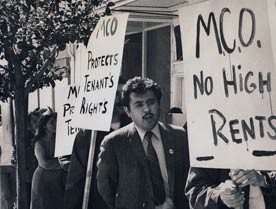
Courtesy of Spence Limbocker
It’s easy to condemn corporate power, profiteering, and executive officer greed; for-sale politicians; and unresponsive bureaucracies. It’s not so easy to criticize innovative, small-scale, community-based, progressive, entrepreneurial, relevant, low-budget nonprofit organizations. And yet, that’s what I propose here to do.
Some years ago I studied the relationship between community organizing and community development corporations. North, south, east, west, the pattern was the same: the former disappeared as the latter appeared.
In New York City, I spoke with a former Harlem tenant union organizer. This once-promising effort of the 1970s had disappeared. “What happened?” I asked. He replied, “The organizers became executive directors and program staff; the leaders became boards of directors; the members became clients.”
In the mid- to late-1960s, I was lead organizer for San Francisco’s Mission Coalition Organization (MCO). Its housing committee organized building-by-building tenant associations that militantly confronted abusive landlords. Its community maintenance committee aggressively dealt with street maintenance, abandoned buildings, and redlining. Its planning committee blocked high-density developments that would have altered the character of the neighborhood. Together, the MCO and its predecessor blocked urban renewal bulldozers from demolishing a community. Parallel action by jobs, education, and other committees yielded similar results.
Model Cities funding ended it all. What had been committees of one organization became separate nonprofit organizations. What had been an organization with an annual convention attended by 1,000 delegates and alternates from 100 organizations with a combined membership of 12,000, who elected their leaders and held them accountable, became self-perpetuating boards of directors unaccountable to anyone. Power-based negotiations with decision-makers, backed by direct action when needed, gave way to supplication and “influence” as these groups first received government funding then had to transition to foundation grants.
The Rev. Johnny Ray Youngblood, a major leader in East Brooklyn Churches (EBC), a broad-based community organization, told a December 1995 funders conference, “Thirty winters ago … we were witnessing some of the key early struggles of the civil rights movement in this country. … It was a time of disciplined demonstrations, civil and mostly civilized disobedience. Thirty winters later, … there are thousands of agencies and programs and development corporations and so-called job training efforts. There are hundreds of conferences and reports and studies. But no war, no battle, no front fully engaged against the forces of deepened poverty and hardened discrimination.”
Youngblood said he “would title his remarks a little differently from the conference theme of ‘collaboration, coordination and community building.’” He preferred “a call for organizing, confrontation and community building.” The funders’ theme of “public-private partnerships,” he said, “usually involve the private sector and the government sector, with a token community advocate or preacher on the board for window-dressing. This kind of response tends to be tame and non-confrontational. … It tends to be small in scale. It tends to be acceptable to funders. … And it tends not to have very much impact.” The sad fact is that what Youngblood said then is still true, if not truer, today.
The case I want to make is not about thinly disguised corporate money expressly trying to undermine social justice work. That happens, but I’m concerned about a subtler, more nuanced problem.
The Slippery Slope
Imagine you are the board of directors and executive staff of a national progressive, even radical, foundation. Your grants are relatively modest: in the $25,000 to $50,000 range. At a major evaluation and planning retreat you decide to make a five-year commitment to racial justice. But you want to make a difference, and that topic is too broad. So you narrow the focus to prison reform. But even that is a wide lens, so you narrow even further and announce a new program thrust — grants for innovative prison-to-work transition projects. Because your grants are relatively small, your rule of thumb here is that you don’t want your grant to be less than 10 percent of a total project budget, so it makes a difference. Let’s call your organization “Advance Foundation.”
Now imagine you are Kwame T. Jefferson, a committed leader in People First, a predominantly voluntary community organization. The focus of People First is building the power to hold public and private institutions accountable and, if required, to transform them so that they better embody values of social and economic justice. You have a “day job,” but your real passion is involvement with prison reform work through People First, to which you give about 20 hours a week. You have become increasingly convinced that you know a key to solving the prison-to-community transition problem. You think a new agency of government ought to be established to establish halfway houses where former prisoners would live with resident counseling teams, therapists, and other support staff to assist them with the transition to mainstream society. And you think that in-prison transition counseling should begin one year before prisoners’ release. In the present political climate, you know that what you want to see happen is not likely. Your organization, and its allies simply lack the power to get the state legislature to adopt a program like this.
Imagine now that Kwame T. Jefferson decides he wants to quit his job and start a nonprofit organization that will let him work on his vision of halfway houses. He knows he will have to keep it small to start, but he thinks if he can just show how well the idea works he can then convince policymakers to adopt it for wider implementation. With help from a nonprofit community-based law firm, he gets his nonprofit started. He and Advance Foundation’s Carmen Huerta start talking about his ideas. She knows he is a smart, effective worker. She suggests some sympathetic “citywide” people for his board of directors to augment those he now has from his low-income neighborhood base. The organization is federally tax deductible [a “501(c)3” in IRS parlance]. To assure stability and continuity, the nonprofit’s bylaws provide for an internal nominating committee that can propose new members to the board — a self-perpetuating body. Huerta introduces Jefferson to some cutting-edge thinkers in prison reform; a couple of them join his board.
Increasingly, Jefferson’s time is taken with writing grant proposals, meeting with policymakers, lawyers, researchers, experts, grant-makers, and others in the prison reform field. In his community, more and more community-based nonprofits are being formed by innovative community thinkers who are seeking funds from innovative foundations — both in the prison reform field, because it is now a hot topic in funding circles, and in other issue areas as well.
Indeed, there is substantial competition among them as the foundations want to maximize the impact of their relatively small amounts of money and are, therefore, seeking the most cutting edge groups. Seeing Jefferson’s nonprofit taking off, Barbara Washington decides to start a women prisoner’s nonprofit. Her focus is different: the gender discrimination dimension of prisoner-release experience. She and Jefferson used to work together in the People First Criminal Justice Reform Committee, so they are friends. But they now barely see one another because each is spending 60 hours a week just keeping his/her organization going. Within their community, the families and friends of prisoners who used to be a major constituency of, and active participants in, People First’s Criminal Justice Reform Committee now come to the respective offices of each program as clients seeking help for their incarcerated relative or friend. The two nonprofits each have a small, overstretched, counseling staff. And there’s now an edge that creeps into the conversations between Jefferson and Washington as each is forced by the need to be innovative to distinguish what each does from the other.
At regional and national meetings of progressive funders Carmen Huerta likes to talk about “her projects” and how innovative they are. And at progressive gatherings of the affluent, Advance Foundation board members offer their cutting edge ideas on prison reform as part of an evening cocktail party’s talk. Other staff and board members from other grant-making organizations like to do the same thing. A climate of constant, unhealthy differentiation is unintentionally fostered as both applicants and grantors want to be unique.
Meanwhile, the largely voluntary People First organization has lost a number of its most talented leaders to executive and program staff positions in community-based nonprofits. And their perspective on how change comes about has changed. Leaders used to understand that they have to change the relations of power in order to effectively pursue their values and interests. Politically, that involves building support both at the base and among elected officials. Economically, that involves strategies and tactics that affect profits in order to compel owners and managers to engage in good faith negotiations. For bureaucracies, it means disrupting business as usual. In people power organizations, leaders learn that whatever the particular issue might be they will be unable to do much about it without power.
But now their perspective has shifted from one of building people power to building innovative programs that will be “models” or “pilot projects” to demonstrate what could be done if the political will was there to do it, and to empowering individuals.
The step-by-step process of building power — get people together; win something small; use the victory to train leaders and create confidence in the efficacy of collective action; reflect on the meaning of what was collectively done from the perspective of basic democratic principles and the social and economic justice teachings of the world’s great religious traditions; use the victory to recruit skeptics (either individuals or organizations) who now see that this organization might know what it’s doing; take on a more recalcitrant target because now you have more people power to negotiate, boycott, disrupt, get out the vote, or otherwise affect institutional power — all this is necessarily abandoned by organizations that are focused now on the competent design of programs.
In the context of community-based nonprofit organizations, different lessons are learned. They are not the lessons of power. Instead of looking at the different self-interests of those with institutional power, self-interests that have to be affected if change is to come about, the focus becomes one of convincing decision-makers on “the merits” of the case. Or, if the language of self-interest and power are still used, sometimes even militantly, there is a sham quality to it because there is no people power army behind the threats. It is “uncle talk tough,” the devil’s advocate in a forum that knows it looks good to let the devil have his say.
Funding Feudalism
The pattern I’ve described is ubiquitous, and its result is separation rather than unification. Rather than finding the lowest significant common denominators that offer the opportunity for broad-based action, there is specialization, particularization, and invidious distinction. Instead of finding ways to build relationships that cross historic lines of division, there is an emphasis on particular identities and the uniqueness of their special form of oppression or exploitation. No form of the left can begin to exercise power in this country if this problem is not tackled. We have no equivalent to the right’s organized base. At present, the sum of our activities is less than the parts.
Who is doing it right? It’s not a mystery: independent community organizing groups, with a membership that pays dues, engages in member-based fundraising activities, elects leaders, democratically determines program, participates in action to change the relations of power, and generally creates a democratic public life. My experience with such groups began as a field secretary for the Student Nonviolent Coordinating Committee and as an organizer with Saul Alinsky’s Industrial Areas Foundation. There are a number of organizing centers that build on similar kinds of experience. They are known and their accomplishments have been evaluated. The principal national organizing “networks” are DART, Gamaliel, IAF, National People’s Action, PICO and US Action; there are spin-offs from ACORN. The National Organizers Alliance can provide a longer list. There are regional and local counterparts to, or affiliates of, these organizations.
How do we strengthen these organizations and stop the slide into particularized program-based nonprofits? First, we need to address the erosion of the social infrastructure that constitutes the civil society base for a progressive politics. Neither single-issue campaign mobilizations nor narrow identity group organizing is sufficient to remedy this. We do not have an equivalent to the right’s rich social networks of theologically and politically conservative evangelical, Pentecostal, and Holiness churches, and homeowner, taxpayer, small business, Realtor, and civic associations (Rotary, Kiwanis, etc).
We need to build base communities, whether through religious congregations or secular counterparts (tenant associations, block clubs, food-buying clubs, baby-sitting pools). Their members need to pay dues. They need to be part of something larger, but unique and independent in their own right. This is not a quick-fix solution. In California, for example, it took almost 30 years of tax revolt before conservative homeowner, property owner, small business, and allied civic associations could win Proposition 13. The tax revolt began as a city-by-city fight against assessments and tax rates. It grew to passage of a statewide proposition whose consequences continue to be felt throughout the country.
Reweaving the fabric of community cannot be accomplished by a single national issue campaign. Community organizers should talk with friendly foundations about this problem and challenge their general preference for issue campaigns.
Second, we need to face the fact that the foundation/external donor to community grantee relationship is essentially a feudal one. Those with money are neither accountable to the market (dollars aren’t spent here by consumers), nor to the electorate (votes aren’t counted by foundation boards of directors). Instead, the relationship is one of a patron. Many valuable things happened historically as a result of wealthy patrons supporting good causes. But it is a relationship fraught with danger for both donor and recipient. And little is now being done by either party to achieve greater accountability of the donors to recipients, or to the community organizing groups representing the constituencies of those recipients.
One way to increase that accountability would be for autonomous, multi-issue, bottom-up, democratic community organizing groups to form intermediary bodies at the metropolitan level that would receive funds from program and advocacy nonprofits to organize the communities those nonprofits seek to serve and in whose name they claim to speak. This should be viewed both as an investment and a tax. These groups could suggest to grantors that their program-, service-, or advocacy-oriented grantees be required to support this intermediary through a line item in their budget. In some cases, there might be a specific agreement by the organizing groups to organize beneficiaries of the other nonprofits, as in residents in a nonprofit housing development.
A new relationship needs to be defined between community-based nonprofits that are program-driven and power-building organizing efforts. Without it, we will continue to win battles but lose the war.





I’d love to hear more about the more nuanced problems you mention…